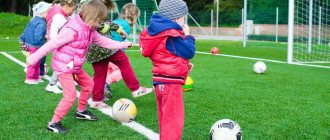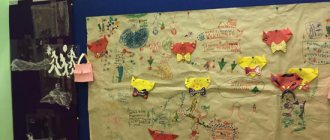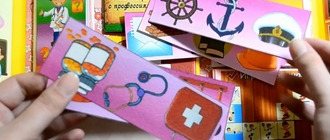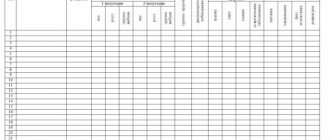Individual educational route for a preschooler as determined by the Federal State Educational Standard
An individual approach to a child’s personality is the basic principle of the Federal State Educational Standard. The principle of priority of the child’s interests was defined by the researchers as “being on the child’s side.” The reason for the difficulties experienced by a child in development should be sought both in the personality of the child himself and in the adults around him, who are directly responsible for the social environment in which the little person grows up. In real life, the child is often the only one on his side. At the same time, he often turns out to be helpless and defenseless in the face of circumstances, so it is important in any problematic situation to hear the child, understand and help him.
The foundation of the modern standard of preschool education was based on the principle of pedagogy of an individual approach and the developmental concept of education. Indicated in the following paragraphs:
- clause 1. 6. - formulation of tasks that concentrate around the creation of optimal conditions for the formation and development of the child’s personality, as well as the disclosure of his creative potential in accordance with his age, psycho-emotional and physiological characteristics, individual abilities and inclinations, and the specifics of the social environment. The child is considered as a valuable subject of relationships with himself, the people around him and the outside world.
- clause 1. 4. - contains the principles of the Federal State Educational Standard, the key of which is the provision on the implementation of an individual approach to the educational needs of each child.
- paragraph 2. 10. 2. - the methods of organizing and coordinating children's initiative and spontaneous activity in the spirit of creative activity are clarified.
- clause 3. 2. 1. - professional selection of forms and methods of pedagogical work that are relevant to the age and individual needs of the child.
- clause 3. 2. 3. - patronage of the child, development of an individual development roadmap, pedagogical and psychological correction of identified problems.
- paragraph 3. 2. 5. - a developmental concept of education aimed at the short-term development of the student.
An individual approach refers to the management of a child’s development, based on a deep, multifaceted study and understanding of the complexity of his inner world and social conditions of life.
Identification of capable children is carried out on the basis of observation, communication with parents, study of individual characteristics
The principle of individual approach pedagogy is not to change the content of education in the interests of a particular child, but to adapt pedagogical methods and techniques to his personal characteristics. For the educational process to be successful, it is necessary to take into account the difficulties that the child experiences and the pace at which he acquires knowledge, skills and abilities. In this case, a model of fruitful partnership between a child and a teacher is being implemented, since the child and parents retain the right to choose the most suitable educational methods from those proposed by specialists.
An individual educational route is a personal way to realize the intellectual, emotional, spiritual potential of a preschool child’s personality. The goal is to create favorable conditions that stimulate activity and the development of the child’s creative and intellectual powers. The teacher’s task is to ensure a competent professional selection of the content of educational, psychological and physical activity, as well as forms and methods of work that meet the individual needs of the child.
Video: individualization of preschool education
Criteria that determine the objectives of an individual development strategy:
- the current level of development of the child’s abilities;
- the degree of his readiness for educational activities;
- individual educational goals and objectives for the near future.
Examples
IOM allows you to unlock the potential of each child and teach him to cooperate with the team
Individual routes, as already noted, do not have an established design scheme; they can be in the form of a table or in the form of text - it all depends on the difficulty the development is aimed at solving. Let's consider two drafting options.
Example No. 1
Difficulties: inattentive and absent-minded, has difficulty solving logical problems and mathematical tasks.
Experiences difficulties in solving logical problems and mathematical tasks.
Month Week Regime moments Direct educational activities Independent activity Interaction with parents January 3rd week Working with the multimedia presentation “Count the contour” Game "Tangram" 4 week Walk “Draw a geometric castle in the snow” Tell your friends about your drawing February 1 week Didactic game “What has changed?” Memo "Games for the development of logical thinking" 2 week Duty in a corner of nature Watering plants based on the description of the flower. Multimedia game "Associations" 3 week Working with punched cards “Number Composition” Teach a friend how to work with a card. Game to visit us. 4 week During morning reception, completing tasks on handout sheets Multimedia presentation “Funny Counting” Check your friend's work. Results of the route : The level of development of attention, concentration and switching has increased. The child copes with tasks of a mathematical nature and logical problems.
Example No. 2
Child's age: 4 years 2 months
Gender: male
Problem: Poor computing skills
The purpose of the individual route: development and consolidation of computing skills within the top ten
Objective: to develop attention, memory, logical thinking.
Frequency of classes: 2 times a week
Duration: 20 minutes
Exercises in class:
- “The numbers got lost” Put the numbers in order Learn to name the numbers in order
2.”What has changed? What number is missing? Name the next and previous digit of the natural series Play the game “Name your neighbor”
3. “Fun little engine” Attach and attach the carriages with numbers to the engine. Solve examples by adding the number 1.
- Put cars in the garage Solving examples by counting units Learn to name the next and previous digit
- “Postman” Deliver letters - examples to houses (solving examples by adding and subtracting numbers 1 and 2) Play the game “Bring a letter to your grandmother, brother”
- “Paratroopers” Each “paratrooper” is given a number based on your own example. Games at home to count objects that surround the child.
- Help Dunno solve examples Solve examples of the top ten using punched cards Solve examples using fairy-tale characters: Piggy, Stepashka, Cheburashka, etc.
- Let's help the hedgehog collect mushrooms. Consolidating computing skills within the top ten. Solving examples at home.
Structure of an individual lesson:
- Organizational moment: a moment of joy.
- A surprise moment: the arrival of a fairy-tale character.
- Main job: help, guess, advise
- work at a magnetic board;
— exercises with handouts;
- work in a notebook.
- Result of the lesson: a minute of communication, what you liked, what caused difficulties, and what was difficult.
Performance evaluation:
As a result of systematic and systematic work with a child who has weak computational skills, by the end of the one-year cycle of classes: computational skills will be strengthened; cognitive interest in mathematics will increase; The child’s mental activity is activated, he will freely perform computational exercises within the first ten. These achievements will help in the future to overcome problems in the mathematical development of preschoolers.
Natalia Sertakova
https://www.maam.ru/detskijsad/individualnyi-obrazovatelnyi-marshrut-na-vospitanika.html
An individual educational route is an effective way to find an approach to each child, to interest him in the learning process or to solve problems of socialization and communication difficulties. With the help of IOM, you can also organize work with gifted children. In subsequent education, the child will be more organized, but, most importantly, he will have the opportunity to choose the activity in which he feels most competent.
IOM tasks, review and approval procedure
Individual educational routes are designed:
- for problem children who experience difficulties in the process of mastering the general education program for preschoolers and need correctional assistance from specialists;
- for pupils with disabilities, disabled children;
- for gifted children with a level of ability exceeding average regulatory educational standards.
The purpose of the individual educational route is to solve the problem of accessibility of preschool institutions for children with disabilities
Leading tasks of an individual educational route:
- provide support and assistance in self-development and mastering the preschool education program;
- to form in the child an initial level of learning ability, i.e. teach him to understand the educational task, plan his educational activities, concentrate on completing the exercise, develop self-discipline and volitional qualities;
- develop and improve movement coordination skills, development of gross and fine motor skills;
- to form and consolidate general cultural, everyday, hygienic, communicative foundations of behavior;
- to accustom the child to manipulative-objective, sensory, practical, play activities, to develop skills in the productive area (drawing, modeling, appliqué);
- develop speech - emotional intonation, grammatical structures, speech mechanisms;
- to generate knowledge about the natural environment and the world of social relations;
- form ideas about spatio-temporal and quantitative categories.
Methodological tools that are used in the passage of an individual development trajectory:
- role-playing and outdoor games, classes in the form of conversation and dialogue, reading and discussion of literary works, small improvisation sketches that enhance the emotional component of information perception;
- psychological trainings and game exercises that help relaxation, neutralize fears, reduce anxiety and aggression, improve behavioral sphere, as well as social and communication skills;
- exercises to develop thinking, imagination, speech, memory;
- use of art therapy techniques (treatment with art, fairy tales, doll making).
Individual attitude and an integrated approach to the problem of development are the key to success even in the most difficult situation!
Development and adoption of the IOM
To create an individual educational route, it is first necessary to conduct a diagnostic study to find out the level of psycho-emotional, intellectual, communicative, social and physical development of the child. The diagnostic results are presented to the teachers' council, which subsequently recommends that the children be examined by specialists from the PMPK (psychological, medical and pedagogical council).
Sample for the conclusion and recommendations of the PMPC
| FULL NAME. child |
| Date of Birth |
| Family information: Mother (full name, education, place of work) |
| Father (full name, education, place of work) |
| Teachers (full name): |
| Specialists: Speech therapist teacher: Speech pathologist teacher: Educational psychologist: Music director: Senior nurse: |
| Health group |
| Regime of a child’s stay in a preschool educational institution |
| Conclusion of the PMPC |
| PMPC recommendations |
| Long term goals |
| Goals for the current period (academic year) |
The council compiles a list of children for whom the development of an individual educational work plan is relevant.
Main stages, structure and content of IOM
A team of educators, in collaboration with specialized specialists, thinks through the content component of the plan. A calendar plan is filled out indicating the elements of pedagogical technology and a list of methodological techniques for achieving the set educational goals.
Basic principles for designing an individual plan:
- Developing a child's learning abilities.
- Continuity and consistency. A team of specialists accompanies the child throughout the entire individual route project until the problem is resolved.
- Refusal of average assessment templates, development of an individual rating scale for each child based on the results of diagnosing the level of his capabilities. In ordinary life, this means that the teacher tries not to use the practice of straightforward “judgment” or “labeling”, comparing the child’s achievements with the generally accepted “norm”. The very concept of “norm” is not perceived as compliance with an average or standard level obligatory for all children, but is interpreted as the best level that a particular child can show in a particular situation. A result that for one child will be regarded as a success, for another, based on his personal level of ability, will be considered a failure. Such a humane approach will allow you to “save face” and self-esteem, and develop self-confidence.
- The beneficial influence of the children's subculture, the enrichment of the child's inner world with informal traditions of the children's environment, forming and strengthening their own experience of a full-fledged childhood. It is important to create an atmosphere of positive emotions that will help overcome tension, anxiety and wariness.
Educational games are used in individual work by a teacher-defectologist, educators for the purpose of correcting emotional and volitional disorders, developing logic, perception, substitution actions, motor skills and perception of colors, ideas about the surrounding world
Stages of educational activities according to an individual plan
- Observation, identification of the level of formation of psychological, social and intellectual qualities of a preschooler’s personality, necessary for his productive activity in any educational field. The observation stage assumes an indifferent approach of the teacher, a position of non-interference when observing the child.
- Diagnostics of the starting volume and qualitative characteristics of specific subject knowledge, skills and abilities. Specialists conduct tests during which problem areas and “success zones” are identified.
- Building a personal plan for correctional work for the near future (up to 1 year with mandatory intermediate monitoring every 3 months) based on “success zones”, individual selection of effective methods and techniques of pedagogical work.
- Active activities to implement an individual route: conducting classes, conversations with parents, homework.
- Analytical stage - summing up, evaluating the results obtained: demonstrating the results of the student’s work in the form of a presentation or exhibition of crafts, speaking to children and adults. In this way, the feedback mechanism with others is activated, and the problem of socialization of students is solved. The results achieved, whether reproductive knowledge or creative projects, are compared with the planned tasks specified in the individual schedule or general education curricula.
To develop harmonious relationships with people around you and solve socialization problems, the following methods will be useful:
- didactic and role-playing games that will introduce the child to the traditions of other peoples and will contribute to the formation of a respectful attitude towards people of other nationalities and cultures;
- reading fairy tales of the peoples of the world, getting acquainted with the folklore (songs, dances, games, holidays) of the peoples of Russia;
- collective outdoor games, holidays and concerts, exhibitions of crafts;
- discussion in a confidential conversation of situations that occur in real life and cause children difficulties in understanding or contain a moral context;
- arbitrary creation of situations that will pose the question of choice and necessity for the child to perform an action;
- holding photo exhibitions in which there is a place for photographs of each baby.
The main goal of art therapy is to harmonize the mental state through the development of the ability of self-expression and self-knowledge
Predicted result:
- achieving social comfort and awareness;
- improving communication skills;
- decreased level of emotional instability, aggressiveness, increased self-control;
- development of self-awareness, a sense of significance and value of one’s own personality;
- formation of self-esteem close to adequate.
Criteria that allow us to assess the degree of success of a preschooler in social and personal growth:
- the ability for self-esteem is formed, the “little man” tries to speak honestly about himself and admit his shortcomings;
- ideas about moral and ethical values have been developed, the baby shares and understands “what is good and what is bad”;
- the conscious need to adhere to moral standards of behavior has become stronger, the child has shown a desire to “be good” and see the positive reaction of people around him to his behavior;
- the child is able to communicate easily and naturally with other children or adults;
- a feeling of empathy and compassion awakens, a sincere desire to help elders, peers or children arises;
- the pupil builds relationships with other children on the basis of mutual understanding and respect, resolves conflict situations with dignity;
- ideas about safe behavior in everyday life, on the street, and at play have been formed.
Content component of IOM
- An introductory part, which records general information about the child and his family, the reasons for developing an individual plan, the goals and objectives of educational work, the schedule and form of classes.
- Registration of data from a diagnostic study of a preschooler, planned monitoring materials, which allow for an in-depth analysis of the symptoms and causes of developmental disorders, to give an objective assessment of the child’s level of development and to plan correctional activities to overcome difficulties.
- A schedule of therapeutic and recreational activities, which includes the distribution of physical activity and procedures for hardening the body.
- A plan of individual lessons, including mandatory integration with educational activities common to all children.
- A report on the implementation of an individual roadmap indicating the topic, content, the result of the lesson and conclusions about the necessary improvements.
- An observation sheet is filled out, which reflects the dynamics of the educational process and helps to make timely changes depending on the results of the intermediate control, as well as determine the choice of optimal forms of pedagogical work to increase the effectiveness of the child’s educational activities.
- Assessment of student achievements in implementing an individual route. It is recommended to conduct control tests at the end of each thematic block, i.e., at regular intervals of three months.
- Recommendations and advisory assistance to parents.
General developmental elements of gymnastics, as well as various outdoor games, are very popular with children and contribute to the mental, psychomotor and emotional development of preschoolers
Sections of the educational route
There are several important sections for developing an individual educational route for a preschooler, which will be discussed further.
General information about the child and family
It is indicated where he came from (family or transferred from another preschool), whether he constantly attended the preschool, if there were long breaks, then indicate the reason. Mark the level of adaptation of the pupil in new conditions on a five-point scale.
Family composition: indicate all family members with whom the student lives.
Describe the type of family:
- prosperous - a stable, strong family with a decent cultural level of upbringing;
- dysfunctional - has a low level of pedagogical awareness, the baby is deprived of parental care and attention, the conflictual emotional atmosphere in the family traumatizes the child, gives rise to psychological complexes, physical methods of influence are used on the child.
Which adult is raising the child?
The child’s relationship style with adult family members:
- authoritarian - strict dictatorship and suppression of freedom, humiliation of the child’s dignity;
- control and guardianship - restriction of independence, protection from worries and problems, “greenhouse conditions”;
- connivance - indulging the desires of the child, spoiling the child with the passivity of adults;
- respect and cooperation - help and support, experiencing difficulties together.
Appearance. It is necessary to note manners, gestures, describe the features of facial expressions, gait and posture, the degree of accuracy and grooming.
“Puppet therapy” is the correction of children’s problems using puppet theater: children perform sketches with dolls according to specially developed scenarios that reflect the individual problems of a particular child
Somatic health
Health group, presence of chronic diseases, appetite characteristics, whether the habit of daytime sleep has been developed, whether the baby suffers from enuresis.
Motor skills:
- general motor skills correspond to the age norm or there are disturbances in motor coordination;
- indicates the range of fine motor skills with characteristics of coordination, pace and volume of motor functions of the hand, left-handed or right-handed.
Cognitive skills
Attention - the ability to concentrate and maintain attention, qualitative characteristics (voluntary, involuntary).
Memory is the speed of memorization, the amount of material that a child is able to reproduce by heart or retell independently from memory, which type of memory (auditory or visual) is dominant.
Thinking:
- degree of understanding of spatial references (above, below, left, right, etc.);
- the ability to select a generalizing word for several homogeneous objects (furniture, vegetables, fruits, animals, etc.);
- the ability to highlight the main thing;
- skills in identifying the simplest cause-and-effect relationships (summer - hot, snow - winter, etc.);
- orientation in time parameters (day, night, year, month, etc.).
Scope of knowledge:
- primary knowledge about yourself and the world around you: knows your name, age, family members, residential address, names the signs of the seasons, has general knowledge about the animal and plant world in accordance with program requirements;
- development of design, drawing, modeling skills;
- level of proficiency in elementary mathematical concepts - ordinal counting skills, solving simple examples;
- skills of identifying and distinguishing shapes and colors.
A problem child especially needs positive emotions, adult support and understanding, and playing with water provides invaluable help in this regard.
Behavior during educational activities
Development of self-control, discipline, organization, determination and awareness of actions in the classroom.
Speech development
Sound characteristics, quality of pronunciation, vocabulary, grammatical organization and structure of speech.
Characteristics of the child's activities
- level of self-service skills;
- interest and personal activity demonstrated in gaming activities.
Features of character and behavior
- emotional portrait of a child - cheerfulness, depression, tearfulness, positivity, depression, calm or hyperactive, etc.;
- character traits, temperamental features - activity or passivity, aggressiveness or poise, confidence or timidity, prefers individual or collective forms of work;
- development of moral guidelines, culture of behavior and communication.
It is necessary to note personal preferences, the scope of the child’s creative or intellectual talent.
Preparation for drawing up a child’s educational route
- Preparation of characteristics of a preschool educational institution student. Has he gone to preschool before? If you did, how long was the break? You also need to assess the degree of his adaptation in the group.
- Next, you need to create a profile of the child’s family. Is it a complete family or not, how many brothers and sisters are there, is the family prosperous. A dysfunctional family can be called one in which they lead an immoral lifestyle, where the parents are too irritated and cruel. A family in which the child’s self-esteem is suppressed. Perhaps the parents are overprotective, protecting the child from difficulties and any efforts on his part.
- You should also note the child’s appearance (gait, facial expressions, posture, etc.)
- Specify health group. Does he have any chronic diseases? Characteristics of appetite and daytime sleep.
- The development of gross and manual motor skills should also be recorded. Which hand is the child's dominant?
- In the next section you need to create a description of the child’s attention, memory and thinking.
- Describe the child’s knowledge in various sections of the preschool program. Attitude to the educational process.
- Make a description of the speech of a preschooler. Vocabulary, sound pronunciation, grammatical formation, coherence and emotionality of speech.
- The teacher should also try to identify a propensity for a certain type of activity.
The teacher must design an individual educational route for a preschooler, involving all preschool specialists in this process. Identification of a child’s abilities occurs during conversation, play, reading, etc.
It is necessary to involve parents in drawing up an individual educational route for a preschooler. The family must adhere to the same criteria for the child’s education as in kindergarten. Only consistency and unity can lead to the desired result.
Sample for filling out general and diagnostic data in the IOM - table
| Full name of the student | |
| Date of Birth | |
| Mother's last name, middle name, age, education | |
| Father's last name, middle name, age, education | |
| IOM start date | |
| Reason for registration | Persistent failure to assimilate OOP of preschool education due to illness |
| Age at the beginning of correctional and developmental work | 4 years |
| IOM goals |
|
| Tasks |
|
| Number of classes per week | 5 lessons. |
| Forms of conducting | Play activities, joint activities, conversations, observations, individual work. |
| Expected Result | |
| Form of work with parents | Consultations, workshop, interview, exchange of experience. |
| Diagnosis of child development | |
| Purpose of pedagogical monitoring | Summarization and analysis of information about the state of general development for assessment, planning of the correctional and developmental process (development of the IOM) and forecasting the final result. |
| Types and causes of difficulties (pedagogical symptoms) | Types of difficulties (pedagogical symptoms): |
| Reasons for difficulties: | |
| Physical development | |
| Somatic development | |
| Speech development | |
| Features of the development of cognitive processes | Memory: |
| Attention: | |
| Perception: | |
| Thinking: | |
| Contents of correctional work (activities of the teacher) | |
After diagnosing and determining the goals and objectives of the compiled route, the teacher and specialists determine which games, exercises and other activities will be used when working with the baby. This is also reflected in the IOM text.






